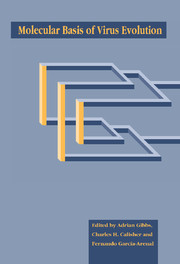Book contents
- Frontmatter
- Contents
- List of contributors
- Editors' preface
- Conference participants
- 1 Introduction and guide
- Part I The impact of viral diseases
- Part II Origins of viruses and their genes
- Part III Sources of virus variation
- Part IV Molecular interactions of viruses and their hosts
- Part V Viruses, hosts and populations
- Part VI Case studies of viral taxa; their systematics and evolution
- Part VII Techniques for viral systematics
- 35 The RNase A mismatch method for the genetic characterization of viruses
- 36 Molecular phylogenetic analysis
- Index
35 - The RNase A mismatch method for the genetic characterization of viruses
Published online by Cambridge University Press: 04 May 2010
- Frontmatter
- Contents
- List of contributors
- Editors' preface
- Conference participants
- 1 Introduction and guide
- Part I The impact of viral diseases
- Part II Origins of viruses and their genes
- Part III Sources of virus variation
- Part IV Molecular interactions of viruses and their hosts
- Part V Viruses, hosts and populations
- Part VI Case studies of viral taxa; their systematics and evolution
- Part VII Techniques for viral systematics
- 35 The RNase A mismatch method for the genetic characterization of viruses
- 36 Molecular phylogenetic analysis
- Index
Summary
Introduction and background
Point mutation has gained a lot of attention in molecular biology because of the implication of this genomic alteration in medicine and pathology, such as genetic disorders and cancers. The RNase A mismatch method was developed for the detection of point mutations related to the activation of the K-ras oncogene in colon tumours using RNA: RNA hybrids (Winter et al., 1985) and to the diagnosis of genetic disorders with RNA:DNA hybrids (Myers, Larin & Maniatis, 1985).
RNA viruses are characterized by great genetic variability. This implies the occurrence of frequent mutation in the genome of different isolates. Some of these mutations are involved in phenotypic properties, such as virulence, tropism, resistance to antiviral drugs and other characteristics (Domingo et al., 1985). They are also the basis for evolutionary studies and strain comparison. Mutations in RNA viruses have been detected by Tl oligonucleotide fingerprinting and lately by sequencing through cDNA.
Our group adapted the system of RNase A mismatch for studies on genetic variability of RNA viruses using influenza orthomyxovirus as a model (López-Galíndez et al., 1988) and Owen and Palukaitis (1988) to plant viruses. The system is based on the comparison by hybridization of a riboprobe from a reference strain with RNAs from different strains. Each one will give a complex pattern of bands resistant to the RNase A digestion which is specific for each one as a fingerprint. Comparing the different patterns we are able to draw a qualitative estimate of genetic relatedness and evolution of field strains (López-Galíndez et al., 1988, 1991).
- Type
- Chapter
- Information
- Molecular Basis of Virus Evolution , pp. 547 - 552Publisher: Cambridge University PressPrint publication year: 1995

